In the Hand – the effect of museum handling sessions on student learning
Alma Boyes and Cynthia Cousens, University of Brighton
This project, In the Hand, set out to assess how handling objects could contribute to an experiential and sensory form of learning, and play an important role in the process of designing and making within the art and design disciplines in higher education. More specifically, it pinpoints the effect of museum handling sessions, where artefacts are brought out of the display case and are availabl...
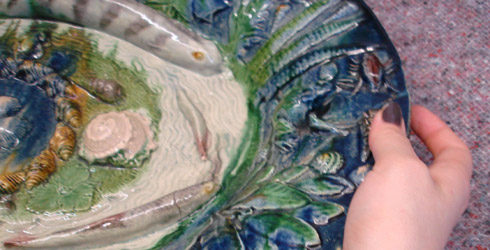
When David Attenborough handled one of the earliest man-made objects, the 1.8 million year old Olduvai Chopping Tool, in the BBC series A History of the World in 100 Objects, he observed: ‘holding this I can feel what it was like to be out on the African Savannas, needing to cut flesh, for example, needing to cut into a carcass, in order to get a meal. Picking it up, your first reaction is it’s very heavy, and if it’s heavy of course it gives more power behind your blow’ (MacGregor, 2010, p.11). This direct tacit reading of objects through touch acts as a potent conveyer of knowledge and understanding about the world we live in, serving to bring powerful connections with people across time and culture. Touch is one of our richest and most complex senses, which Elizabeth Pye in The Power of Touch describes as inviting ‘the interrelation of rhythm, movement, contact, proprioception, articulation and pressure, and with it we can perceive shape, space, size, texture, temperature, vibration and response’ (Pye, 2010, p.91).
Our project In the Hand set out to assess how handling objects could contribute to an experiential and sensory form of learning, and play an important role in the process of designing and making within the art and design disciplines in higher education. More specifically, it pinpoints the effect of museum handling sessions, where artefacts are brought out of the display case and are available to hold or look at closely, on the student learning experience. The project aimed to inform teaching, and the curricula in which it could take place, in order to improve the student experience, and also to provide evidence to contribute to improving museum accessibility and education provision for HE students.
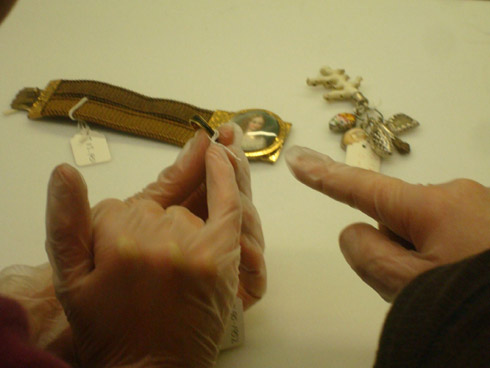
Figure 1
Our previous research project Teaching and Learning through Practice, (Boyes, Cousens and Stuart, 2008) noted the increasing dependence in education on two-dimensional or virtual representation of objects, and focused in particular, on categorising and investigating the rich range of non-verbal communication used in teaching technical demonstrations. Unpublished data within this project from a handling session at the V&A museum, which indicated substantial impact on student learning, formed the foundations for In the Hand.
Our research also builds on a cluster of design pedagogy research projects relating to museums and HE, which were funded by the Centre of Excellence in Teaching and Learning through Design based at the University of Brighton. Examples include those documented in the publication Museum and Design Education: Looking to Learn, Learning to See (Cook, Reynolds and Speight, 2010); projects such as Sources of Inspiration - how design students learn from museum collections, (Wisker, 2008) and Behind the Scenes (Cook, 2009) which evaluated tutors’ needs from handling sessions and the museum’s potential to deliver.
There has been an move from museums towards a more open and inclusive educational environment: the new V&A Ceramics Galleries, which opened in 2009, include publically accessible rooms for handling sessions and artist residencies and the educational department at MoMA have set up open, drop-in project spaces for visitors. There have also been a number of projects such as Museumaker, in which makers were commissioned to work with museum collections, for example Clare Twomey who installed Dark Day in Paradise in the Brighton Pavilion in 2010. At the British Museum, Grayson Perry’s recent major exhibition, The Tomb of the Unknown Craftsman 2011, alsoincluded his selection of artefacts from their collections alongside his own work.
The research for In the Hand was undertaken in two parts. The first part being the analysis of the data collected from the earlier V&A handling session in 2007, which informed the content of the semi-structured interviews and self-completing questionnaires used for the collection of further data. It also allowed a longitudinal study to be set up by interviewing these students three years after the original handling session.
The second part of the project involved the development and implementation of further handling sessions at the V&A during 2010-11, enabling in-depth research into students’ immediate response and comparison between the ‘before’ and ‘after’ effects on work and student learning. Images and statements by the students about their work were collected before and after the handling sessions, and interviews were held five months later at the conclusion of the student projects at their graduation exhibition.
Third year students from the BA Materials Practice course at the University of Brighton volunteered to take part and selected seven to eight artefacts from the V&A’s ceramics and jewellery collection website to handle at each session. The artefacts were presented by the Ceramics Curator in the public galleries and by the Jewellery Curator in the metalwork department offices on the top floor of the V&A, which are not normally open to the public (see Figure 2). There were strict codes of conduct and handling, with gloves for the jewellery, and for one very fragile object, the Etruscan gold bowl, a restriction to visual observation only. The sessions were recorded through photography and audio-visual recordings.
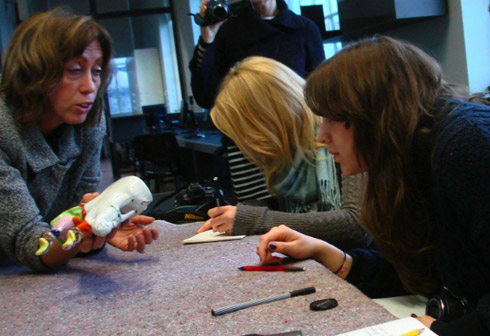
Figure 2
The data revealed that the handling sessions benefitted the students in two key areas: an increased awareness and understanding of the physicality of objects and their making, and also a powerful long-lasting impact on their attitudes and approach to work.
The students commented on the value of the in-depth examination of a few selected artefacts from the collections in comparison to previous visits where they had viewed the numerous artefacts on display in the public galleries more superficially. In particular they gained significant insight and understanding of the physical and material aspects of objects through the direct experience of handling the artefacts ‘in the flesh’. They developed an increased awareness of colour, texture, weight and scale, which they felt was hard to establish in a display behind glass or from a publication. Being able to explore the pieces by turning them over, looking inside and carefully interacting with moving parts brought an increased understanding of manufacture and construction methods (see Figure 3).The quality of craftsmanship also impacted on the students’ work and is evident in this student’s statement: ‘it certainly started off a different level of making for me, [the] standard of my work has changed in its quality’.
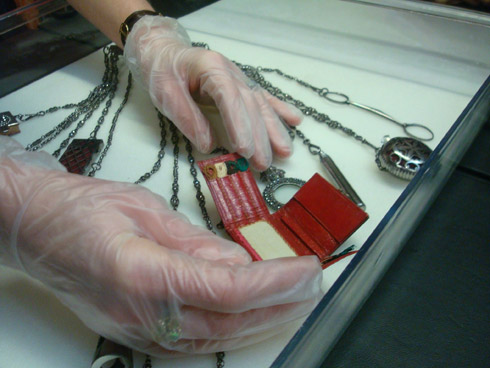
Figure 3
The artefacts themselves were both directly and indirectly inspirational in the evolution of the students’ work, which manifested itself visually, technically, or metaphorically through the historical stories that surround the pieces as retold by the curators. Others were deeply influenced by the way the artefacts were stored and the respect and value afforded them through the museum and, in turn, learnt to value their own work more highly. A student acknowledged: ‘I have to understand that they are pieces of work they are not just a project, they are in the world now and I think that the visit has made me understand their preciousness in a way’.
The world-class reputation of the venue was important and one student commented that ‘the history that goes with the V&A as well as its standing’ made her ‘feel like being one of the best’. The contextual, historical and object knowledge displayed by the curator proved to be a significant contribution and the emerging discussions involving curator, tutor and student were valued. The session connected the students to the wider canon of subject history, through object exemplars of the highest standing (see Figure 4).The power of touching these gave a strong personal connection with the past, to makers and users of the object, and one student said she ‘felt emotionally involved touching them, knowing their stories and knowing real people had also touched them’.
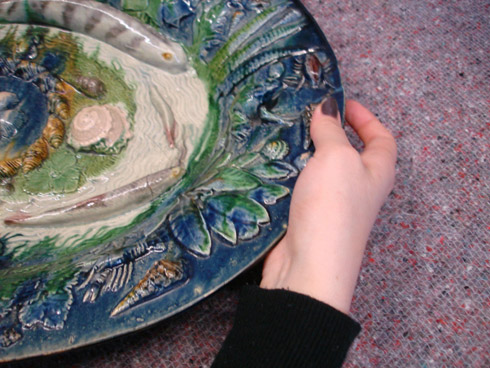
Figure 4
In the longer term the handling sessions formed a powerful and memorable ‘once in a lifetime’ experience - ‘a magical experience’ and one of self-discovery ‘like a key to a kingdom’. An unanticipated outcome was that nearly all the students perceived the session as an experience that made them feel ‘honoured’ or ‘feel special in some way [which] adds a level of taking yourself seriously’. For some this was connected to the session’s exclusivity, viewed as being out of the mainstream of the curriculum or general public experience, and to the ‘behind the scenes’ aspect of the session.
The experience provided an example of deeper learning, impacting deeply on the students’ attitudes and approach to work. It gave them confidence, status and raised their aspirations, enabling them to take themselves more seriously as makers and increasing their sense of self-belief. As one student stated, it made her feel ‘part of a community of people who make things that span peoples and time – you become part of that’.
The students indicated that they would like to see handling sessions of this calibre take place as a voluntary, but core part of their course and we plan to work in partnership with local and national museums to incorporate this in the curriculum as an annual event for the third year students.
Biographies
Alma Boyes is a Senior Lecturer and Acting Academic Programme Leader for Design & Craft at the University of Brighton having been engaged in teaching and her own practice as a sculptor since 1982. From 2006 she has been working with colleague, Cynthia Cousens, on pedagogic research into practice-based teaching concluding a series of research projects funded by CETLD, CETL Learn Higher and ADM-HEA, delivering papers at major conferences nationally and internationally including CLTAD’s 4th & 5th International Conferences and at Making Futures in Plymouth in 2009.
http://arts.brighton.ac.uk/staff/alma-boyes
Cynthia Cousens is a Senior Lecturer in Design and Craft at the University of Brighton. She is also an established jeweller with work in the collections of the V&A and National Museums of Scotland, amongst others, and having exhibited and lectured internationally. Pedagogical research projects include a series with colleague, Alma Boyes, including Observational Learning through Professional Studio Practice and See What Happens! – the value of creative experimentation through materials with Avril Wilson and Patrick Letschka.
http://arts.brighton.ac.uk/staff/cynthia-cousens
References
Boyes, A. Cousens, C. and Stuart, H. (2008) ‘Teaching and learning through practice’, http://arts.brighton.ac.uk/research/cetld/speaking-and-writing-the-visual/exploring-the-relationship-between-teaching-and-learning-through-practice.
Boyes, A. and Cousens, C. (2010) ‘Observational Learning through Professional Studio Practice’, http://arts.brighton.ac.uk/research/cetld/learning-through-the-design-process/observational-learning.
CETLD http://arts.brighton.ac.uk/research/cetld.
Chatterjee, H. J. (2010) ‘Object-based learning in higher education: The pedagogical power of museums’, University Museums and Collections Journal, Vol.3, pp.179-182.
Cook, B. (2009) ‘Behind the Scenes’, http://arts.brighton.ac.uk/research/cetld/speaking-and-writing-the-visual/behind-the-scenes-at-the-museum.
Cook, B. Reynolds, R. and Speight. C. (2010) Museums and Design Education: Looking to Learn, Learning to See, Farnham, Ashgate.
Cousens, C. Letschka, P. and Wilson, A. (2009) See what Happens! - the value of creative experimentation of materials http://arts.brighton.ac.uk/research/cetld/speaking-and-writing-the-visual/see-what-happens!
Heller, M. (2009) Touch, Representation and Blindness, Oxford, Oxford University Press.
Macgregor, N. (2010) ‘A History of the World in 100 Objects’, BBC Radio 4 podcast and book of same title, Allen Lane London.
Museumaker http://www.museumaker.com.
Pye, E. (2007) The Power of Touch: Handling objects in museum and heritage contexts, Walnut Creek, CA, Left Coast Press.
Wisker, G. (2008) ‘Sources of Inspiration - how design students learn from museum collections’, http://arts.brighton.ac.uk/research/cetld/speaking-and-writing-the-visual/sources-of-inspiration.
Yentob, A. (2011) ‘Imagine - Grayson Perry and the Tomb of the Unknown Craftsman’, BBC1 production.
Photos: Alma Boyes
Figure 1: Metal handling session V&A museum 2011: a sense of discovery
Figure 2: Ceramics handling session V&A museum 2010: with the curator
Figure 3: Metal handling session V&A museum: detail of Victorian Chatelaine showing students experiencing movement 2007
Figure 4: Ceramics Handling Session V&A museum 2011: the Palissy Dish
Header image: Section from Figure 4


